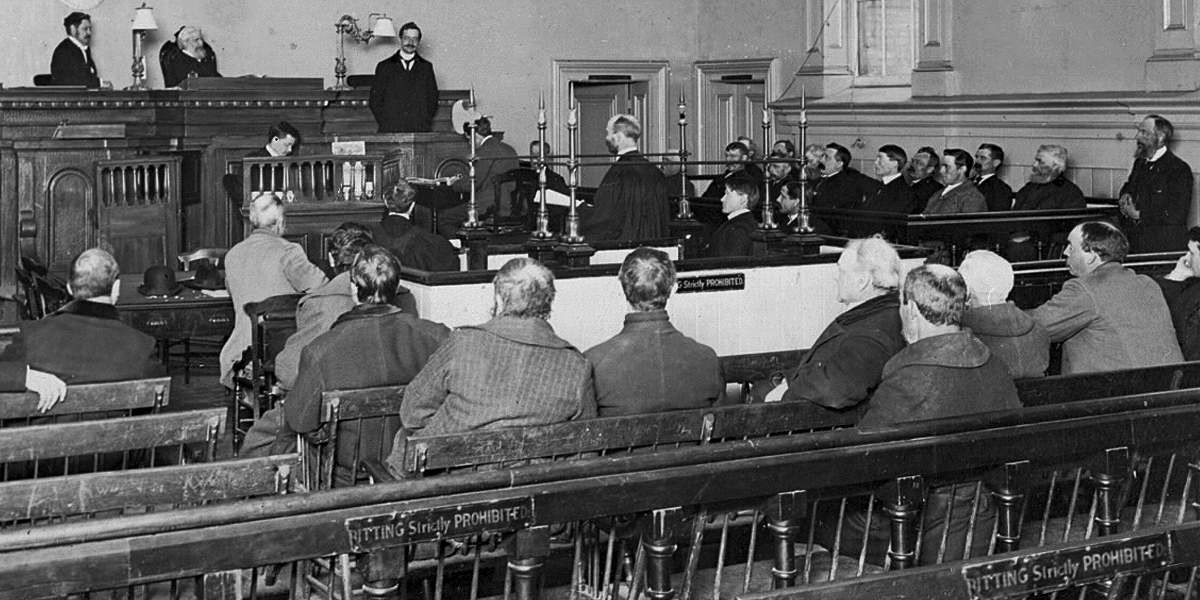Bloody Tangipahoa shootout assessed in court
Before his death on October 9, 1899, Tangipahoa Parish Sheriff’s Deputy Avery R. Draughon told fellow deputies that Gage and Alonzo Gill accosted him at the train station in Tangipahoa and shot him three times. Aleck and Jim Gill promised Deputy Sheriff W. J. Mullins their brothers would surrender by week’s end, but that never happened.
Avery R. Draughon died in a hospital, Hotel Dieu, in New Orleans. Coroner G. R. LeMonnier found that traumatic peritonitis from an infected gunshot wound caused Draughon’s heart to stop. Undertaker P. J. McMahon embalmed the body the same day, loading it on a train back to Tangipahoa. There, sheriff’s deputies, assisting Draughon’s family, unloaded the body at the depot where the shooting began.
On November 15, 1899, the governor of Louisiana issued a proclamation reading:
“I, Murphy James Foster, Governor of the State of Louisiana, have thought it proper to issue this, my proclamation, calling upon the good people of our state to aid and assist the authorities in procuring the arrest of two fugitives so they may be brought to justice and dealt with as the law directs. By virtue of the authority in me by law, I do hereby offer a reward of $400 for the arrest and conviction of Alonzo and Gage Gill.”
Deputy Sheriff Mullins arrested the Gill brothers the following year, and they stood trial in January 1901. On day four of the trial, a 10-year-old boy named Willie Ricks took the stand, reliving what he saw on October 7, 1899:
“I live east of the town of Tangipahoa a few miles. I was in town that day and witnessed part of the difficulty. I was on the railroad. I saw Alonzo Gill and Avery Draughon walk onto the gallery in front of Mr. Sanders’ store. They walked to the door and Avery Draughon turned, drew his pistol, and made three attempts to shoot Alonzo Gill, but Alonzo knocked his pistol away each time. Avery was facing Alonzo and backed off the gallery. As he reached the ground, he shot at Alonzo Gill, but the pistol was knocked up again, and then several shots fired. Draughon got wounded as he walked away toward his store. After he crossed the street, his wife met him and took the pistol out of his hip pocket.”
Gage Gill refused to testify, but Alonzo took the stand on day five, insisting Gage shot the deputy in self-defense. He told the court that, shortly before the shootout, a farmer, Elias Wainwright, told him that “Avery Draughon would shoot him the first chance he got.” Gage, he said, shot Draughon to protect his brother.
On the stand, Elias Wainwright remembered saying, “I would not be surprised if Avery didn’t have a hidden pistol, and if he gets to it, he will shoot them.” However, he testified, his remark came as the Gill brothers fumbled with Draughon’s vest. Wainwright told the judge, “I thought he would shoot them, just because they were abusing him.”
In his closing arguments, District Attorney Robert Ellis said the state had proven its case with “overwhelming testimony.” He said they had shown how Gage and Alonzo instigated and perpetrated the murder after assaulting the victim in the street.
Defense Attorney M. W. Davidson opened with a statement reminding the jury that any reasonable doubt that the brothers provoked the attack required a vote for acquittal, and he recounted Alonzo’s assertion that Gage believed Draughon planned to kill one or both brothers.
Judge M. A. Stickland, sick with the flu, took the stand to define self-defense according to Louisiana law. Judge Gordon W. Goodbee took the stand to counter, explaining how Louisiana lawyers often skew that definition.
Colonel J. W. Sentell, attorney for the Defense, suggested that Avery Draughon overstepped his authority and acted as a vigilante. State Attorney Clay Elliot countered, reminding the jury that Avery Draughon was not the one on trial.
Several reputable character witnesses took the stand for both sides, but Duncan S. Kemp, the leading counsel for the Defense, told the jury to ignore them all. He asked them to forget the passionate remarks shared that day. Instead, he said, they should render a decision based solely on the law and the evidence provided. He next recounted the testimony of each who had come before and explained why their words met the definition of hearsay in the eyes of the court. He concluded with a plea to the jury to return a verdict of justifiable homicide.
Saturday morning, January 26, 1901, Judge Robert “Bob” Reid reminded the jury the trial would end in a hung jury unless they returned a unanimous verdict. One hour later, the jury rendered a not guilty verdict.
Three days later, Deputy Sheriff W. J. Mullins arrested one of the jurors from the trial. Long before jury-tampering was a legal term, a grand jury indicted Benjamin J. Scarborough with perjury. The court believed he lied to the court when he stated he had no preconceived verdict before the Gill trial began. Scarborough’s fellow jurors told the grand jury that “B.J.” strong-armed their group into voting not guilty.
Scarborough’s trial, like that of the Gills, ended with an acquittal.

